June 16, 2015 | Posted in TRADITIONAL ART AND PAINTING | By sockii
Learning the Craft of Painting via Art Reproduction
Many beginning artists scoff at the idea of reproducing other artists’ work, especially when first presented with the idea in an art class or workshop. Of course, most artists become interested in painting because they have their own visions and ideas to share. Yet there is much that an artist can learn through copying the work of others. Art reproduction, particularly the reproduction of famous works by well known Old Master or classical artists, can be an important learning tool in gaining a deeper understanding of art techniques, methods and what makes for a “good” painting.
An instructor once put it to his class this way: How does a musician learn about music? A beginning musician does not immediately pick up the violin or sit at a piano and begin composing his own works from scratch. A musician learns by studying and playing works composed by others, perfecting his skill until he can recreate these songs or concertos or arias to the best of his ability. A gifted musician can then put his own unique spin on these works by others, and then, perhaps, compose his own works to be shared – and reproduced – for generations to come. The same approach can be applied to the visual arts, especially for those artists interested in classical realism in oil painting.
Read on to learn more of the benefits of reproducing artwork as a learning aid for artists.
Learning through Art Reproduction: A Perfect Introduction to Classical Techniques
The Best Way to Learn from the Old Masters is to Copy Them
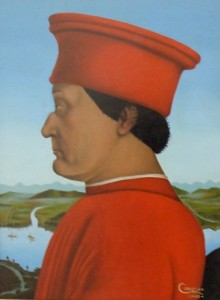
Reproduction of “Portrait of the Duke of Montefeltro” by Piero della Francesca. Copy done by my partner David Carrozzino.
Reproduction is often utilized in art classes and workshops focused on traditional oil painting techniques. This approach makes sense on many levels, as certainly, one of the best ways to “prove” to a student that these techniques work is to see a final painting that actually does look like a Rembrandt, Titian, da Vinci, Durer or Vermeer. Granted it’s rare that an artist’s first attempts at reproduction work will fully capture every detail and aspect of what made these paintings so impressive, but even coming close can reinforce to a student the benefits of classical methods.
Many beginning oil painters look at works from Renaissance and later realist artists with awe and wonder, overwhelmed by the idea of creating such works themselves and the techniques that must be involved. It’s not so simple as just throwing down colors on a blank canvas; most classical artists took a very methodical approach to their work beginning with a carefully planned under-drawing, an initial layer or two of under-painting, then the application of color through various approaches and often many layers and glazes before completion. It is easiest to teach this approach to art students through the act of reproduction of classical work, instead of trying to do so with a completely original subject. Once students and young artists have become familiar with these techniques, they can begin to apply them to their own original works of art.
Becoming Intimately Familiar with Art through Reproduction
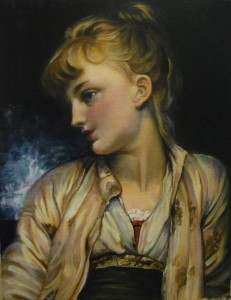
My reproduction of Lord Frederick Leighton‘s “Gulnihal”.
There is no finer way to become deeply familiar with a work of art than to study it in detail by attempting to reproduce it. Looking at an image in a book or hanging on a wall in a museum is one thing; studying it brushstroke by brushstroke as you attempt to copy it is another matter entirely.
Truly, you will never look at a particular work the same way again, nor the original artist who created it. My appreciation for numerous artists and their techniques has increased dramatically each time I’ve worked on a reproduction of one of their paintings. And each time I worked on a reproduction, I also learned something from the experience to add to my repertoire of tricks and techniques.
The image to the right was a reproduction of Lord Frederick Leighton’s “Gulnihal” which I began in a painting workshop and continued working for nearly a year until I considered it complete. It was the first time I had attempted a reproduction of a 19th Century English artist’s work, and the experience was quite different from the earlier Renaissance artists I had copied in the past.
Tips for Getting the Most from Art Reproduction Work
Keep These Suggestions in Mind Before Beginning on a Copying Project
-
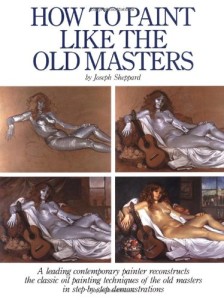
“How to Paint Like the Old Masters” by Joseph Sheppard. This book is an excellent resource for artists interested in learning the techniques of the old masters. The painting methods of Durer, Titian, Veronese, Caravaggio, Vermeer, Hals, Rubens, and Rembrandt are each described, from their underpaintings to choices of paint color, atmosphere, blending and lighting effects. The author then presents an original subject representative of each artist, and shows step by step how he painted them using their techniques. Available now at Amazon.
Start with single subject images at first, so as not to be overwhelmed by detail and subject matter. A simple portrait, focused on the torso upward, is generally your best choice.
- Choose a canvas or panel size that is as close to the original painting’s proportions as possible. Since composition is an important part of a successful work of art, you don’t want to have to crop the image you are reproducing awkwardly.
- If you have the opportunity to view the original artwork on display in a museum before beginning to work on your reproduction, this is ideal. Copies in books and on poster prints often lose detail worth studying, or may alter the color balance.
- Select a single reference image to work from and stick to it. Get the best resolution image you can find to start with (see below for advice on that) and then don’t go looking for others. There can be extreme differences in how colors are reproduced from one photograph of an oil painting to the next; detail lost or found; contrast heightened or lessened. If you try to work from multiple reference images at the same time you are likely to only make yourself completely confused and frustrated.
Finding Good Images to Work From When Reproducing Paintings
A Quality Reference Picture is Essential
Having a high resolution, large print of a painting you wish to copy is an important step in working on an art reproduction. Posters from museums generally work well, but often the painting you wish to copy may not be available unless it is a popular image such as the “Mona Lisa” or “Girl With a Pearl Earring.”
A good source on-line for high quality realist art images is the Art Renewal Center. Their virtual museum is one of the largest depositories of art images on the internet, and many are available for download in very high resolution. ARC also offers high quality fine art prints, up to 36×44 inches, of many of the images in their collection. Their emphasis is on reproducing original colors as accurately as possible and maintaining original painting dimensions, so for the serious reproduction artist their work is certainly one of the best options to consider for your reference images.
Another Reason to Consider Reproducing Classical Artworks
They’re Great Sellers!
Any artist, professional or semi-professional, with tell you that the business these days is tough. Unless you’ve got an “in” with the right gallery or the right niche market, getting people to invest in your original work can be challenging. Yet many casual art fans with a little bit of disposable income will immediately respond to a familiar image or work they’ve seen in a museum collection before. I’ve found it easier to get a fair price, and fair interest, in well-done reproduction artwork than selling work featuring original subject matter, at least as an independent artist.
That’s not to say I would discourage an artist from putting the time and effort into doing original work. But, if the bills are building up and sales are slow, consider trying a reproduction or two and seeing what response you receive. My highest price-tag art sale to date was for my Titian painting shown at the top of this webpage. People at art fairs and festivals immediately respond to a familiar image, even if you use it to draw people in to then look at your other work.
Taking a Class or Workshop Focused on Fine Art Reproduction
The Best Way to Learn is With an Instructor

An instructional video program by Liliedahl Studios. Available for purchase at Amazon.
If you are interested in exploring the craft of reproducing classical art work, the best way to begin is through a structured class or workshop. There are many schools and private instructors who offer such classes, where students are taken step-by-step through classical painting techniques while reproducing a famous work of art. For some courses, you will have to choose from a limited selection of recommended images; for others, you will be given more freedom in choosing the image you’d like to reproduce. Frank Covino is a wonderful artist and teacher who offers workshops throughout the United States, focused on classical techniques. Indeed, he has many students who take his workshops repeatedly and he insists that they cannot bring in an original subject or photo-reference to paint until they have completed several fine art reproductions under his tutillage. The Angel Academy of Art in Florence and The Academy of Realist Art in Boston and Toronto are two schools which offer workshops regularly focused on old master techniques and reproductions. There are many more out there, so just spend some time on the internet exploring!
You can also order video/DVD series from artists which include detailed instructions on reproducing classical works of art. Liliedahl Studios offers many instructional art DVDs including ones focused on reproducing the works of Waterhouse and Bouguereau.
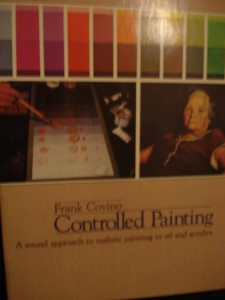
“Controlled Painting” by Frank Covino. Available at Amazon.
“Controlled Painting”
The Classic Painting Book by Frank Covino
If there is one book on classical techniques I’d recommend to any artist, it would be this outstanding volume by artist Frank Covino. A passionate defender of traditional oil painting techniques and methods, he will take you step by step through the methods of the old masters and how to apply them in both reproducing paintings and creating your own original work.
Although long out of print, there is a reason this volume always commands a high price on the used/collectible book market – artists who have tried Covino’s methods know they are just that good. Covino teaches nothing but art reproduction to new students in his workshops, and this book presents many of the techniques and lessons found in his classes so you can study them at home.
You can listen to and watch a brief sample of Frank Covino working with students in the video included below:
Related posts at Spacial Anomaly
Table of Contents
- Learning the Craft of Painting via Art Reproduction
- Learning through Art Reproduction: A Perfect Introduction to Classical Techniques
- Becoming Intimately Familiar with Art through Reproduction
- Tips for Getting the Most from Art Reproduction Work
- Finding Good Images to Work From When Reproducing Paintings
- Another Reason to Consider Reproducing Classical Artworks
- Taking a Class or Workshop Focused on Fine Art Reproduction
- “Controlled Painting”
sockii
sockii is just your typical Jane-of-All-Trades who never has enough time in her day for all of her projects. She has written for many websites online including Squidoo, Zujava, Yahoo! Contributors Network, HubPages and Wizzley. She has been attending and vending at science fiction and media conventions for over 15 years, and for several years ran an art gallery and jewelry store in Philadelphia. Today she is happy to be living in South Jersey with her partner David and their 6 cats. Sockii is a member of several affiliate sales programs including Amazon Associates and Viglink. Products from these services may be advertised on her posts and pages to generate sales commissions.
4 Comments
- Reproduce a Renaissance Portrait Painting - […] If you’d like to learn more about how art reproduction is a valuable learning tool for artist, read my…
Leave a Reply
*

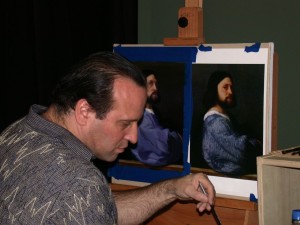
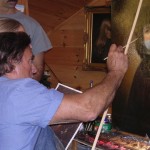
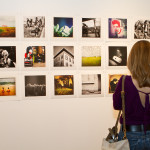

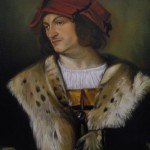








Barbara Radisavljevic
June 17, 2015
Some people learn to write the same way — by rewriting the work of skilled writers. I believe Benjamin Franklin did that. i appreciate your very thorough article.
Ewan McNaughton
November 8, 2015
There is also an academy of realist art in Edinburgh now, for those living closer to the uk. Workshops include old master reproductions.
http://www.academyofrealistart.co.uk
Wonderful article!
sockii
November 8, 2015
Thank you very much, and that is great to hear about the new academy. Edinburgh has been on my list of places I’ve wanted to visit for some time, so I will keep an eye on your workshop schedule in the future.